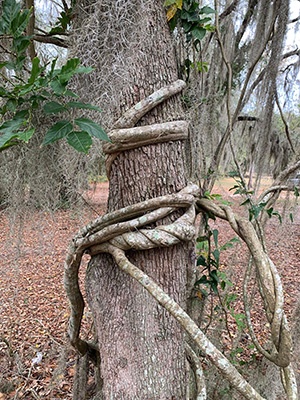Wisteria


Wisteria is a perennial vine with wonderfully fragrant flowers, often lavender, that grow in clusters, similar to grapes.
But the wisteria common throughout the Southeast is actually an invasive from China. Chinese wisteria grows so rapidly that it covers plants, shading out others and even killing trees.
Chinese wisteria (Wisteria sinensis) is able to damage local ecosystems because of its rampant growth and ability to thrive in a number of different conditions. While Chinese wisteria won’t produce its trademark flowers without sun and prefers rich loam, this resilient vine will still grow in shade and tolerates any soil.
Wisteria can climb up tall trees and will continue to grow in the tree canopy where it can shade out smaller trees and plants below. Additionally, individual wisteria plants can live for more than 50 years; wisteria’s longevity only increases its ability to invade an area and choke out native plants.
Removing Invasive Wisteria

If you want to remove invasive wisteria species from your landscape be sure to do so carefully. The best way to eliminate wisteria from your landscape is to cut the vines off as close the root as possible and “paint” the cut stem with glyphosate (i.e. Round-up) or Garlon (i.e. Brush B Gone). This process can be repeated if you wisteria resprouts. Remember, wisteria can grow from seeds or rooted stolons, so be sure to properly dispose of your cut vines to prevent an infestation. Proper disposal of wisteria involves putting it out for curbside pickup where available.
If you don’t want to use herbicides you can simply cut the vine off as close to the root as possible, but be aware that wisteria will continue to sprout after being cut, so you will have to cut it back every few weeks until fall. You can also remove the entire plan by digging up the roots. Any root pieces left in the ground may resprout so be on the lookout for wisteria growing back. Again, be sure to properly dispose of your unwanted wisteria.
Non-Invasive Wisterias
For those who wish to incorporate flowering vines into your yard, do your landscape and the environment a favor and find a nursery that can recommend a non-invasive plant. Another good reference is the EDIS publication “Flowering Vines for Florida,” which provides photos, information on growing regions, and flowering times on a number of flowering vines ideal for Florida landscapes.

American wisteria (Wisteria frutescens) and evergreen wisteria (Millettia reticulata) are two lovely, non-invasive options for your home landscape. The native American wisteria cultivar ‘Amethyst Falls’ has deep blue/purple flowers and blooms in the spring and summer. The blooms may not be quite as fragrant, but won’t need the constant pruning and caution associated with Chinese or Japanese wisterias.
An added bonus, American wisteria is a larval host plant to both the silver-spotted skipper and the long-tailed skipper butterflies. American wisteria is only hardy in USDA zones 5 to 9, so it will not perform well in all parts of Florida.
Luckily, gardeners throughout the state can replace invasive wisteria with the fragrant flowering vine evergreen wisteria, sometimes called summer wisteria. Evergreen wisteria is a non-native, non-invasive vine with glossy, leathery green leaves and small, fragrant flowers that bloom during the summer. Evergreen wisteria (which is not truly a wisteria), is hardy in USDA plant hardiness zones 8 to 10 and will grow best in areas with full sun, but will tolerate partial shade.
Both of these vines are more delicate and grow less aggressively than invasive wisteria, making them ideal for cultivation in your home landscape.
Also on Gardening Solutions
More from UF/IFAS
- Five Facts: Wisteria in Florida–Florida Museum
- Silver-Spotted Skipper; Epargyreus clarus (Cramer) — Ask IFAS
- Wisteria sinesnsis, Chinese Wisteria–UF/IFAS Assessment of Non-Native Plants in Florida’s Natural Areas
- Wisteria floribunda, Japanese Wisteria–UF/IFAS Assessment of Non-native Plants in Florida’s Natural Areas
